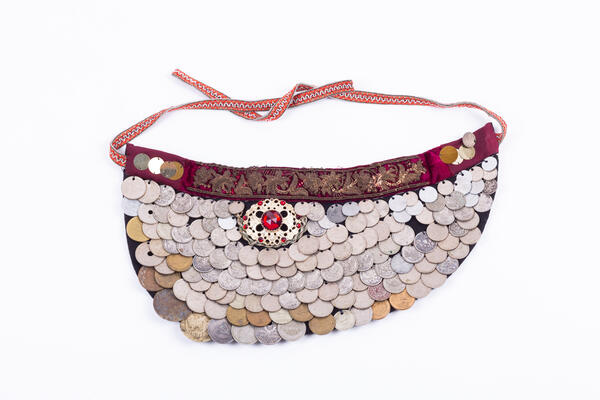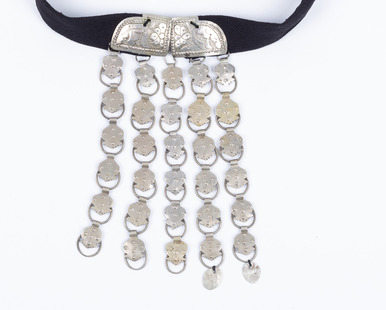The Bashkir adornments are a result of a centuries-old history of people engaged in livestock breeding. The Bashkirs decorated their clothes with coins, shells, corals, and beads. Jewelry was often made of carnelian, amber, beads, and processed glass. They purchased some of these materials from Oriental and Caucasian peoples.
In the past, a sash called ‘a khasite’ was very popular among the Bashkir women of fashion. These sashes could decorate everyday, festival, and even ritual clothes. These accessories were an integral part of the Bashkir national female costume. A khasite also could provide information about the social status of a wearer and her family affiliation.
The decoration reminded of a wide band. It was made of red, orange, or yellow thick cloth decorated with coins, precious stones, and silver circles. Corals, large and small beads were often used for an exquisite decoration.
Traditional beliefs determined the choice of decorative elements. Thus, the superstitious Bashkirs believed that a khastie was a powerful good luck charm protecting the wearer from the evil spirits. Mother-of-pear, chalchuite stones, corals, carnelian, and silver decorating a sash, warded off the evil creatures.
A sash was worn over the left shoulder, under the right arm so that the chest and the back were tightly covered. The fastener was on the shoulder or under the arm. Sometimes a khasite was made without a fastener. Then the decoration formed a ring. The lower part of a sash under the arm featured a small metal or a fabric case. Women put a small Koran, or some religious texts in it.
The Bashkir people living on different territories had different decorations. So, the North-Eastern Bashkirs called their sash ‘emeyzek’. It was quite wide: about 20 cm. The band was decorated with small silver coins and corals with a fringe in the lower part. The Northern Bashkirs called the sash ‘dauet.’ They decorated the band with openwork buckles, carnelian and sometimes with passementarie.
In the past, a sash called ‘a khasite’ was very popular among the Bashkir women of fashion. These sashes could decorate everyday, festival, and even ritual clothes. These accessories were an integral part of the Bashkir national female costume. A khasite also could provide information about the social status of a wearer and her family affiliation.
The decoration reminded of a wide band. It was made of red, orange, or yellow thick cloth decorated with coins, precious stones, and silver circles. Corals, large and small beads were often used for an exquisite decoration.
Traditional beliefs determined the choice of decorative elements. Thus, the superstitious Bashkirs believed that a khastie was a powerful good luck charm protecting the wearer from the evil spirits. Mother-of-pear, chalchuite stones, corals, carnelian, and silver decorating a sash, warded off the evil creatures.
A sash was worn over the left shoulder, under the right arm so that the chest and the back were tightly covered. The fastener was on the shoulder or under the arm. Sometimes a khasite was made without a fastener. Then the decoration formed a ring. The lower part of a sash under the arm featured a small metal or a fabric case. Women put a small Koran, or some religious texts in it.
The Bashkir people living on different territories had different decorations. So, the North-Eastern Bashkirs called their sash ‘emeyzek’. It was quite wide: about 20 cm. The band was decorated with small silver coins and corals with a fringe in the lower part. The Northern Bashkirs called the sash ‘dauet.’ They decorated the band with openwork buckles, carnelian and sometimes with passementarie.



